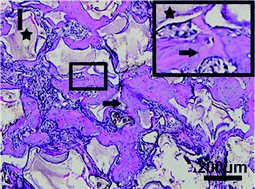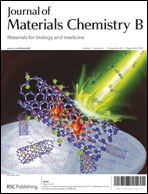Strontium-incorporated mesoporous bioactive glass scaffolds stimulating in vitro proliferation and differentiation of bone marrow stromal cells and in vivo regeneration of osteoporotic bone defects
Abstract
Osteoporosis is one of the most widely occurring bone disorders characterized by low bone mineral density and poor bone strength. Strontium ranelate, as a treatment option, has received significant attention in recent years due to its ability to halt the progress of osteoporosis by simultaneously improving bone formation and reducing bone resorption. Although much emphasis has been given to the treatment of osteoporosis and fracture prevention using pharmacological agents, much less attention has been placed on the repair of critical-sized bone fractures caused by osteoporosis. The aim of the present study was to prepare strontium-incorporated mesoporous bioactive glass (Sr-MBG) scaffolds in order to combine the therapeutic effects of Sr2+ ions on osteoporosis with the bioactivity of MBG to regenerate osteoporotic-related fractures. Prior to animal implantation, the effects of Sr-containing ionic products from Sr-MBG scaffolds on the proliferation and differentiation of bone marrow stromal cells (BMSCs) from osteoporotic bone were investigated in an in vitro culture system. The results showed that Sr-MBG scaffolds significantly increased the proliferation of BMSCs in a concentration dependent manner and were able to stimulate the expression of osteoblast differentiation markers including Alpl, Col1a1, Runx2 and Bglap as assessed by real-time PCR. Critical sized femur defects in ovariectomised rats were created to simulate an osteoporotic phenotype. At time points 2, 4 and 8 weeks post-implantation, the in vivo osteogenetic efficiency was systematically evaluated by μCT analysis, hematoxylin and eosin staining, and immunohistochemistry (type I collagen). The results showed that the incorporation of Sr into MBG scaffolds significantly stimulated new bone formation in osteoporotic bone defects when compared to MBG scaffolds alone. Furthermore, it was generally found that Sr release in blood was maintained at a very low level and the Sr, Si, Ca and P excretion by urine operated in an a similar manner to blank control animals. Our results suggested that Sr-MBG scaffolds could be a promising biomaterial for regenerating osteoporosis-related fractures by the release of Sr-containing ionic products.


 Please wait while we load your content...
Please wait while we load your content...